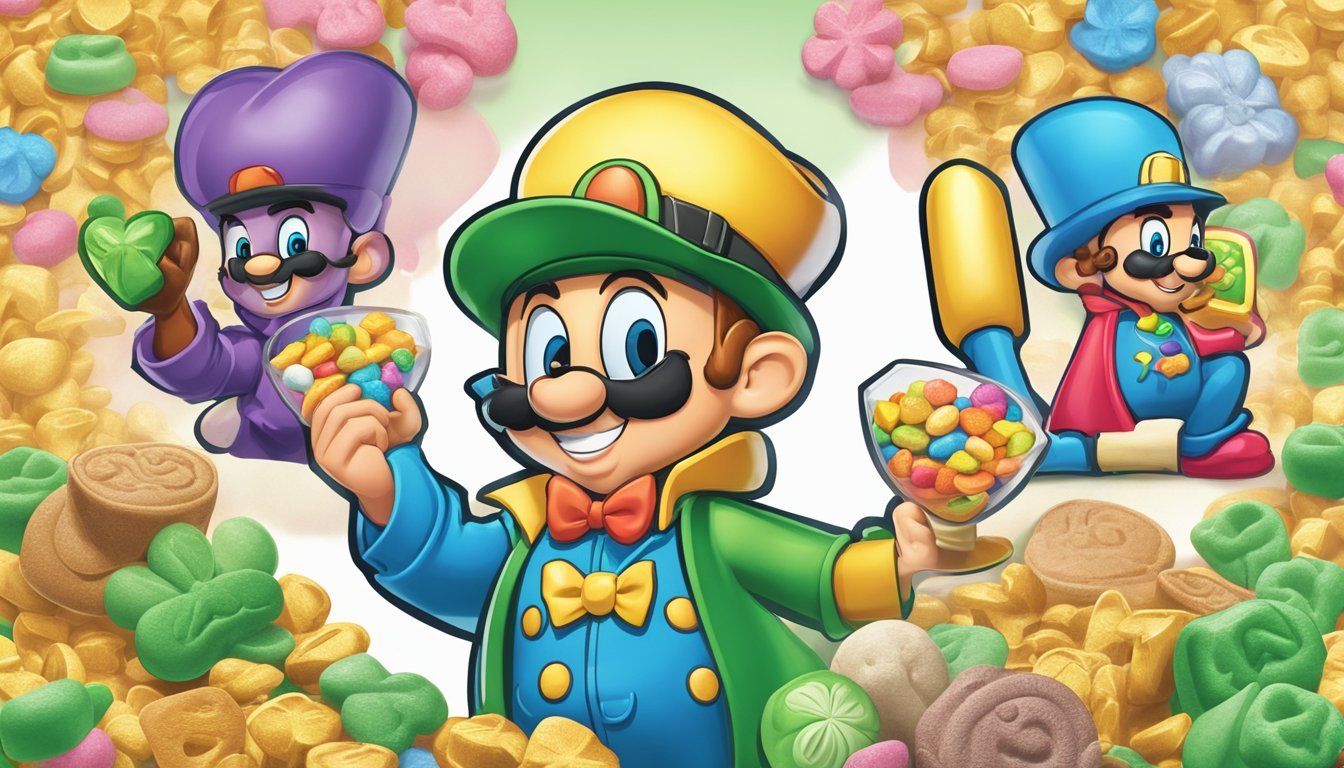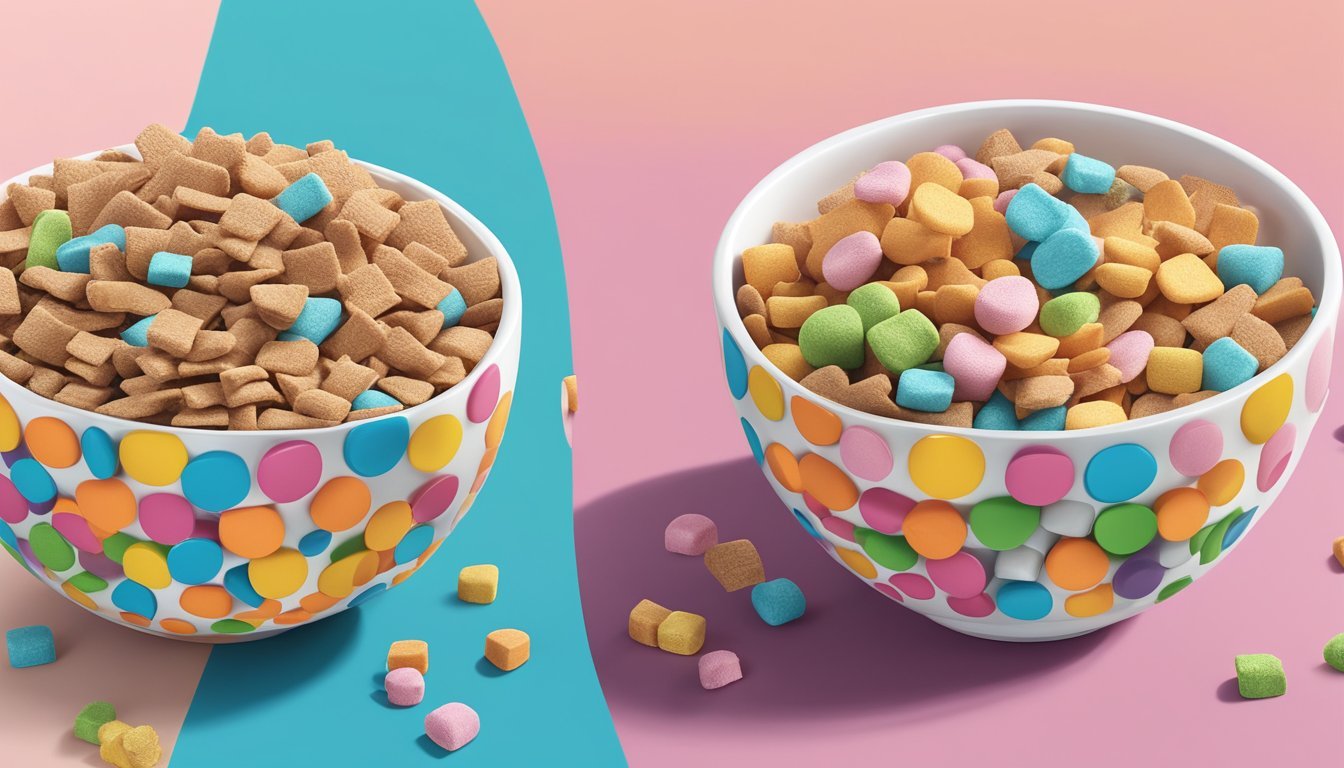Krave vs Lucky Charms
Comparing Nutritional Value and Taste
This Article is Part of Our Breakfast Cereal Guide with Details on Krave Nutrition and Lucky Charms Nutrition
In the realm of breakfast cereals, Krave and Lucky Charms stand as prominent options that cater to different tastes and preferences. Krave, known for its chocolate-filled biscuits, appeals to those with a craving for a rich and indulgent start to their day. In contrast, Lucky Charms, with its iconic marshmallow bits, evokes nostalgia and promises a whimsical breakfast experience.
When choosing between Krave and Lucky Charms, the deciding factor often hinges on nutritional content and personal taste preferences. Krave offers a unique blend of textures with its succulent chocolate-filled centers, which may be more satisfying for chocolate lovers. Lucky Charms, on the other hand, is famous for its colorful marshmallows and sweeter flavor, appealing especially to those who enjoy a sweeter breakfast treat.
Both cereals offer distinct breakfast experiences. Krave's chocolatey delight provides a rich indulgence that can satisfy sweet tooth cravings, while Lucky Charms' playful mix ensures a touch of magic in every bite. As consumers weigh their options, the choice between these two cereals ultimately comes down to individual taste and desired nutritional value.
History and Brand Overview
Krave and Lucky Charms both have distinct origins and developmental milestones that have established them as recognizable brands in the breakfast cereal market.
Evolution of Krave Cereal
Krave, introduced by Kellogg's, made its debut in 2012. Aimed at younger audiences, it combined crispy, multi-grain cereal pieces with a smooth, chocolate filling.
Chocolate was a key element, setting it apart from traditional cereals.
This innovation capitalized on the rising trend for indulgent breakfast options.
Marketing targeted taste and texture, highlighting its appeal to those seeking a more dessert-like experience in a bowl.
Since its launch, Krave has expanded its flavors and varieties, continuing to satisfy its niche in the market for chocolate lovers.
The Legacy of Lucky Charms
Lucky Charms, produced by General Mills, has been a staple since 1964. It featured a unique combination of oat pieces and colorful marshmallows.
The marshmallows, known as "marbits," were a revolutionary addition to breakfast cereals.
The mascot, Lucky the Leprechaun, became a significant part of the brand's identity.
These elements contributed to its enduring popularity among children and adults alike.
With its memorable advertisements and evolving marshmallow shapes, Lucky Charms has maintained its relevance for over half a century.
Nutritional Comparison
Comparing Krave and Lucky Charms reveals differences in caloric content, sugar levels, protein, fiber, whole grains, and vitamin and mineral fortification. Insights on these variances will guide healthier breakfast choices.
Caloric Content and Serving Size
Krave and Lucky Charms differ significantly in caloric content per serving. Krave offers approximately 120 calories per serving (about 31 grams). Lucky Charms provides around 110 calories per serving (about 27 grams).
The serving sizes differ slightly, with Krave serving size being larger. This impacts overall calorie intake. Parents selecting cereals for children should note these differences. A higher serving weight in Krave means potentially higher satiety, while Lucky Charms, with its appealing marshmallows, might encourage overconsumption.
Sugar Content Analysis
Sugar content is a crucial consideration. Krave contains about 11 grams of sugar per serving. Lucky Charms contains slightly more, with 12 grams of sugar per serving.
High sugar intake can be a concern, especially for children. Both cereals are high in sugar, contributing significantly to daily sugar intake recommendations. Consumers looking to reduce sugar intake might need to reconsider both options or opt for unsweetened varieties.
Protein, Fiber, and Whole Grain Contents
Krave offers more protein and fiber compared to Lucky Charms. It contains 2 grams of protein and 2 grams of fiber per serving. Lucky Charms, on the other hand, provides 2 grams of protein and 1 gram of fiber per serving.
The presence of whole grains also varies. Krave includes whole grains, which is beneficial for digestive health. Lucky Charms contains less whole grain, making Krave a better option for those prioritizing whole grain intake.
Vitamin and Mineral Fortification
Both cereals are fortified with essential vitamins and minerals. Krave is enriched with nutrients like iron, calcium, and B vitamins. Lucky Charms also boasts fortification with vitamin C, iron, calcium, and zinc.
The inclusion of these micronutrients can aid in meeting daily nutritional requirements, especially for children. The slightly higher variety of vitamins in Lucky Charms might offer a more comprehensive micronutrient profile. Parents should evaluate individual needs when choosing.
By focusing on these nutritional aspects, consumers can make informed decisions about their cereal choices.
Flavor Profiles
Krave and Lucky Charms offer distinct and memorable flavor experiences. Krave focuses on rich chocolate varieties, while Lucky Charms features a mix of sweet cereals and colorful marshmallows.
Krave's Chocolate and Other Variants
Krave is known for its chocolate-filled cereal pillows. The exterior is crunchy, offering a satisfying texture contrast to the creamy chocolate center.
Krave also offers other flavors, including Peanut Butter Chocolate and Double Chocolate. Each variant maintains a strong base flavor of chocolate, appealing to those who crave indulgence in their breakfast.
Limited editions sometimes bring in new combinations, adding diversity to their lineup while ensuring the core chocolate element remains.
Lucky Charms' Classic Taste and New Flavors
Lucky Charms combines mildly sweetened oat cereal with various marshmallow shapes, commonly referred to as "marbits".
The classic taste is characterized by the contrast between the crunchy oat pieces and the soft, sugary marshmallows.
Recent additions like Chocolate Lucky Charms and Fruity Lucky Charms expand the flavor profile. Chocolate Lucky Charms blend cocoa-infused cereal with the traditional marshmallows. Fruity Lucky Charms add a tangy twist without losing the signature marshmallow charm.
These new flavors capture attention while adhering to the iconic taste that fans love.
Ingredient Quality
The quality of ingredients in Krave and Lucky Charms varies significantly, especially in terms of natural versus artificial components, and the use of preservatives and artificial colors.
Use of Natural vs. Artificial Ingredients
Krave and Lucky Charms use a mix of natural and artificial ingredients. Krave typically contains whole grains but also includes artificial flavors to enhance taste. Ingredients like hydrogenated oils may also be present.
Lucky Charms prominently features artificial flavors and colors in its iconic marshmallows, with ingredients such as corn syrup and modified corn starch. Additionally, Lucky Charms has whole grain oats as a primary natural ingredient, which offers some nutritional value.
Presence of Preservatives and Colors
Krave tends to include preservatives to maintain freshness and extend shelf life, using synthetic additives in some cases. The presence of artificial colors might be minimal compared to other cereals.
Lucky Charms, on the other hand, relies heavily on artificial colors to create its colorful marshmallows. Ingredients like Yellow 5 and Blue 1 are commonly used. Preservatives are also part of the ingredient list to ensure the cereal lasts longer without losing its texture or taste.
Market Position and Consumer Preferences
Krave and Lucky Charms occupy distinct places in the cereal market, each with unique strengths and target audiences. They are both popular choices but appeal to different demographics and consumer preferences.
Popularity Rankings
Lucky Charms is one of the top-selling cereals in the U.S. General Mills reports that it ranks within the top ten, fueled by its widespread appeal across age groups. The inclusion of marshmallows has made it particularly attractive to both children and adults.
Krave's popularity, though not as high as Lucky Charms, still ranks well among chocolate-flavored cereals. Kellogg's marketing strategy highlights its chocolate-filled pieces, catering mainly to younger consumers and chocolate lovers. Despite its appeal, Krave has yet to achieve the same widespread recognition.
Target Demographics
Lucky Charms mainly targets children with its colorful marshmallows and playful Leprechaun mascot. However, a significant proportion of its consumers are adults, with over 40% of buyers being older than 18. This dual appeal helps it maintain a strong market position.
Krave, on the other hand, is focused on teenagers and young adults who prefer indulgent, chocolatey flavors. The brand positions itself as a more "mature" option compared to other sugary cereals, attempting to bridge the gap between fun and sophisticated tastes. This niche targeting helps Krave maintain steady but focused consumer interest.
Dietary Considerations
Both Krave and Lucky Charms cereals present distinct dietary profiles that cater to different nutritional goals and sensitivity to allergens. Key points include their alignment (or lack thereof) with health-conscious diets and potential allergen concerns.
Compatibility with Health-Conscious Diets
When evaluating Krave and Lucky Charms for health-conscious eating, it's important to look at sugar content, fiber, and whole grain usage. Krave contains 160 calories per serving, with 3.5 grams of fat and 12 grams of sugar. It offers more sugar and fats compared to some other cereals, which can be a concern for those monitoring sugar intake closely.
In contrast, Lucky Charms also has a high sugar content, featuring 12 grams per serving. Although it contains less fat than Krave, the added sugar can impact those aiming to reduce sugar consumption. They have about 140 calories per serving and are known more for their sugary taste than their nutritional benefits.
Cheerios is often highlighted as a healthier alternative due to its use of whole grains and lower sugar content.
Allergens and Dietary Restrictions
Krave includes ingredients like wheat and soy, which are common allergens. Its ingredient list does not cater specifically to gluten-free diets, making it unsuitable for individuals with celiac disease or gluten sensitivity. Furthermore, the presence of soy could pose issues for those allergic to soy products.
Lucky Charms, on the other hand, contains wheat, which is unsuitable for gluten-free diets. However, Lucky Charms has introduced a gluten-free version, catering to those with specific dietary restrictions.
Dairy allergies are less of a concern for both cereals since neither Krave nor Lucky Charms inherently contain dairy ingredients, although cross-contamination in manufacturing facilities can occur.
Environmental and Ethical Impacts
Choosing between Krave and Lucky Charms involves considering not only their taste but also their environmental and ethical impacts. The sustainability practices and ethical sourcing of ingredients offer essential insights into their overall responsibility towards the planet.
Sustainability Practices
Lucky Charms, like several other oat-based cereals, contribute to sustainable farming. Oats planted as cover crops can improve soil health between main crop cycles like corn and soy. This practice reduces soil erosion and enhances nutrient content.
Krave, on the other hand, does not prominently feature such sustainable practices. The brand focuses more on cocoa and rice, which don't have the same recognized environmental benefits as cover crops. Evaluating sustainability initiatives is crucial to understanding a product's broader impact.
Ethical Sourcing of Ingredients
Lucky Charms uses oats, potentially sourced through more sustainable methods. Ethical sourcing often includes considerations of how materials are produced, transported, and their impact on local communities. Though not heavily marketed, Lucky Charms may benefit from these standard agricultural practices.
Krave’s use of cocoa raises questions about its sourcing. Cocoa farming often faces scrutiny over ethical issues like child labor and poor working conditions. Without clear commitment to Fair Trade or similar certifications, Krave's ethical sourcing practices remain less certain.
Evaluating how ingredients are sourced helps consumers make informed decisions and supports better farming practices worldwide.





